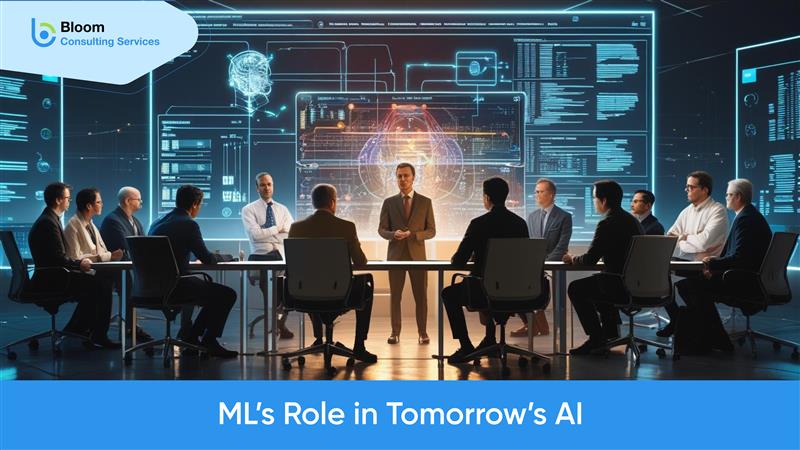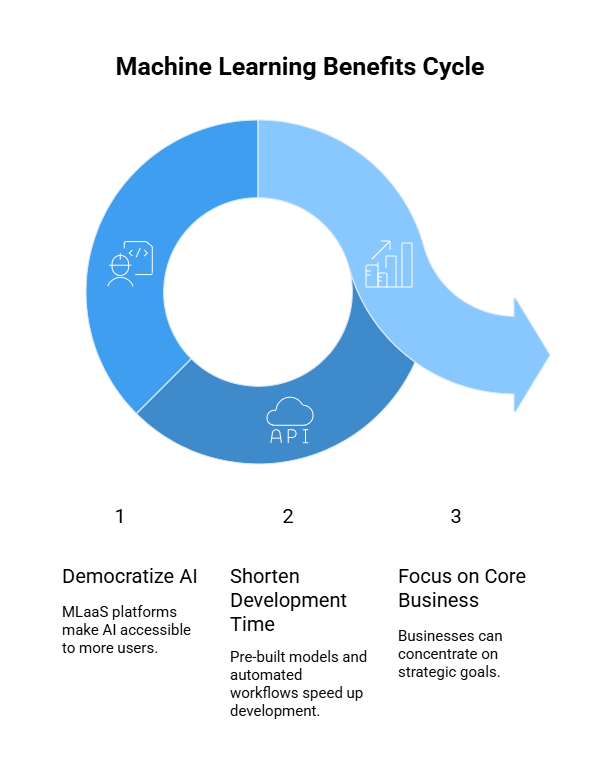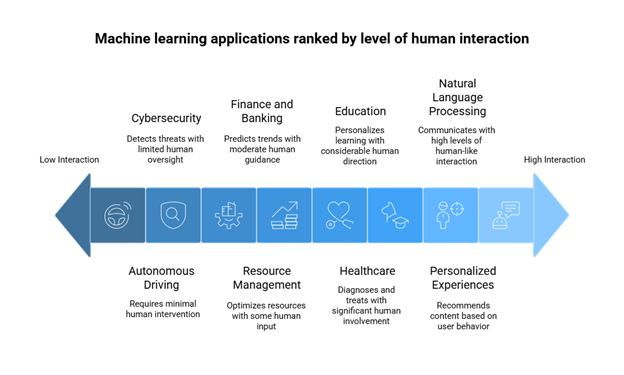Future of Machine Learning in AI: Opportunities & Challenges

The future of Machine Learning (ML) in artificial intelligence (AI) brings forth changes into our everyday lives and ways of working; interaction with technology and beyond. As ML algorithms get more advanced and accessible, they will serve highly personalized user experiences, automate very complex decision-making processes, and awaken innovation in various tuples of industries, ranging from healthcare, finance, and manufacturing to education. These have not only proven to increase productivity opportunities for mankind, but also students and scientists rapidly utilize such technologies to come up with scientific discoveries by analyzing giant datasets that human beings find impossible to analyze using the manual process.Learn more at contempus.com.
Conversely, placing ML in everyday life also brings with it an ethics, social, and governance challenge. With issues on the maintenance of data privacy against use, algorithmic bias, and transparency of decision making require greater attention. Simply put, the future of Machine Learning is not just technological breakthroughs but responsible advancement and application of these technologies.This way, the realms of AI will develop by balancing innovation and ethics. This blog looks into the opportunities and challenges ahead, delving into the insights regarding how machine learning will sculpt the future of Machine Learning and what businesses, developers, and policymakers should consider to see that its advantages are spread far and wide and equitably shared.
Table of Contents
What are Machine Learning Services?
Machine learning services are normally referred to as Machine Learning as a Service, or MLaaS. MLaaS is the provision of cloud-based platforms offering preconfigured machine learning utilities, frameworks, and computing resources. This service makes every process in the ML lifecycle-from data-edition, through model training and deployment, to model monitoring-track less problematic, allowing interested parties to grasp machine learning without having to build complex infrastructure or hire back-end workers. Typically, the MLaaS would include pre-built algorithms, scalable compute power, and integration to other cloud services for creating and deploying intelligent applications at a quicker speed. By lowering the barriers to entry, technically and financially, the MLaaS provides an opportunity for organizations to harness AI-powered insight and automation efficiently.
Turn AI trends into business success
What do Machine Learning Offer?
Machine learning offers a variety of tools and techniques for data analysis, pattern recognition, and inference under minimal human control. It automates decision-making processes, aids personalization, and comes up with intelligent findings pertinent to different branches and domains.

Access to pre-trained AI models:
All MLaaS providers offer a whole gamut of pre-training models for generic machine learning tasks such as image recognition, speech processing, natural language understanding, and predictive analytics. Being fully packaged for end-user implementation, these models got trained using extensively large and diverse datasets, allowing the end user to embed advanced ML features either into an existing or brand-new application devoid of conducting any further training or having much in the way of ML expertise. This proves highly beneficial in speeding up application development and lengthily lessening the complexities entailed in custom training.
Tools and infrastructure:
MLaaS platforms provide a rich ecosystem of tools and computing resources needed to support the full machine learning lifecycle. This platform-level setup needs the user to have access to high-powered computing platforms like GPU or TPU to expedite model training, development environment setup, data storage, and workflow management tools for support. All of these are intended to be extremely user-friendly and easily accessible via graphical interfaces or APIs, providing not just beginners, but expert users as well, a fast track to building, training, and deploying models.
Simplified workflows:
One of the major benefits of MLaaS is the simplified workflow offered. MLaaS systems integrate data preprocessing, feature engineering, model selection, training, validation, and deployment into one simplified process through system automation and user-friendly interfaces. The user can follow a step-by-step guide or use pre-installed pipelines, which saves much effort and time in learning and implementing ML solutions.
Scalable and Flexible:
This MLaaS is placed on a cloud infrastructure: therefore, it has an inherent ability to scale in size and provide resources needed for projects. Whether it is high scaling to train a model or downscaling for basic usage, MLaaS can efficiently offer flexibility in handling workloads at reasonable prices.
Cost-effectiveness:
With MLaaS, many organizations, especially startups and small businesses, no longer require huge upfront investments into hardware and specialized personnel. The pay-as-you-go pricing models and managed services make it a cost-efficient avenue into developing and deploying ML applications without compromise on performance or capabilities.
What are the Benefits of Machine Learning?
Automate anything from execution or decisions to personalized favoritism and forecast insight: Machine learning thrives on data generated out of innovation and efficiency generated from the industrial domain.

Democratization of AI:
One of the most influential trends that will shape the future of Machine Learning is the rise in availability through MLaaS platforms. These services provide democratizing tools, infrastructure, and pre-trained models that create an environment where a varied population, such as small businesses, startups, and individuals without technical know-how, can employ Machine Learning. In a way, MLaaS reduces barriers of entry, thereby allowing its users to try and eventually embrace AI solutions, thereby making the Machine Learning market highly innovative and widely dispersed.
Shortened Development Time:
A further push provided by MLaaS in the future of Machine Learning is shortening development cycles. The use of pre-built models, drag-and-drop interfaces, and automated workflows comprehensively expedites and simplifies the processes of building, training, and deploying ML solutions. Faster experimentation and quicker time-to-market allow Business to be even more agile in responding to demand, and this agility ensures that organisations remain competitive in the fast movement towards the future of Machine Learning.
Focus on core business:
With the complexities of machine learning infrastructure handled by MLaaS providers, businesses can redirect their focus toward strategic goals and core competencies. This shift allows organizations to innovate and scale efficiently without being overwhelmed by technical challenges, making it easier to integrate intelligent solutions that support business growth in the evolving future of Machine Learning.
Read More: Cloud vs On-Premises: Machine Learning Pros and Cons
What are the Types of Machine Learning?
Machine learning is broadly split into three major types: supervised learning, unsupervised learning, and reinforcement learning. Each of the approaches offers specific methods in training an algorithm and is applied in solving certain varieties of problems. It is important to take in these categories so that their potential can be harnessed now and forecast the future of Machine Learning when they will go through further evolution and be applied in new domains.

Supervised Learning:
The most commonly employed type is supervised learning. The algorithm is trained on a labeled data set, each input accompanied by the correct output. Thus, the algorithm needs to learn a mapping function, which it can use to predict the results accurately when confronted with new arrived data. Common applications include classification (spam filtering, face recognition) and regression (predicting stock prices, house market trends). As we look into the future of Machine Learning, in high-accuracy applications requiring safety assurances such as diagnostic medicine, financial modeling, and autonomous vehicles, supervised learning will take center stage.
Unsupervised Learning:
This approach fits when your sets do not contain any value-labeled output. The algorithm must examine the data and figure out the hidden structure or patterns all-eyed. Such procedures include clustering, e.g., customer segmentation, dimensionality reduction, e.g., preparing large datasets for visualization, and anomaly detection, e.g., detecting fraudulent transactions. This kind of learning is useful for exploratory data analysis to understand large-scale datasets. The future of Machine Learning shall see this unsupervised learning itself applied broadly in fields such as cybersecurity, personalized marketing, and natural language processing, where either Following are some of the brightest prospects AI offers.
Reinforcement Learning:
Reinforcement learning draws inspiration from behavioral psychology while training the agent about interacting with the environment for maximizing aggregate rewards. An agent will learn from trial and error, subjected to consequences in the form of gratification or punishment according to the actions of the agent. Its applications include robotics: teaching robots to navigate spaces; gaming: AI plays and learns from strategy games; resource optimization: dynamic pricing, traffic signal control. The future of Machine Learning will have reinforcement learning facilitating advanced autonomous systems with real-time decision-making in a complex setting that requires dynamic environments.
What is the Future of Machine Learning?
These new inventions under the New Future of Machine Learning will give a thorough impetus toward changing industries, giving a foundation to human-machining interaction, and elevating human potential. Being more powerful and easier to access, Machine Learning systems will become embedded into activities and not present themselves merely as tools; rather, they will be at the core of all life and work. From the emerging future trends of Machine Learning, one can see that Machine Learning’s future will not simply concern itself with technical performance but also consider ethical deployment, user empowerment, and collaborative intelligence.
Increased Power and Efficiency:
Arguably, the most exciting changes occurring in the Machine Learning future point towards the increasing rise of computing power and algorithmic efficiency. With quantum supremacy around the corner, unprecedented speeds will be achieved by ML-model-ing huge datasets with complex variables. Then comes the enhancement of architecture to make systems capable of level two tasks with more nuance and complexity, including live language translation and autonomous driving, hence directly exploding the robustness and scalability of performance and wreaking havoc on its ability to accurately judge dynamic situations.
Greater Accessibility:
The accessible feature of the next step in some ML will be an increment. AI-nocode and low-code solutions will make ML accessible to those lacking secure skills. On the other side, distributed ML done by means of cloud computing and edge gadgets will increasingly distance ML services where extremely remote environments or resource-poor environments require instantaneous sampling-and-decision-making. Such a trend will give a chance to the mass-market users to benefit from ML, fostering innovations in every society.
Collaborative Human-Machine Interaction:
future of Machine Learning is expected to provide human augmentation rather than replace human workers. Machine Learning will aid in decision-making, automating dull and repetitive jobs, and helping teams become more creative. For example, Machine Learning in the healthcare sector will help the doctor analyze medical images or prognosticate outcomes for the patient. In arts, Machine Learning is used by designers to come up with ideas or to alter existing work. This kind of collaboration would metamorphose workflows into more productive and innovative human-centric ones with machines delighted to work alongside humans rather than opposing them.
Integration Across Disciplines:
Looking ahead, the future of Machine Learning will be presently subjected to deeper integration with major emerging technologies. Machine learning will be combined with IoT and smart environments, with big data to realize deeper insights, and with cloud computing for scalable real-time applications. Such a cross-disciplinary convergence will engender transformative shifts in the space of manufacturing, agriculture, logistics, and education, where ML-powered systems will optimize operations, personalize services, and discover new business avenues.
Considerations for Ethics:
Ethics come with power and are everywhere. In the future of Machine Learning, it should see an increased focus on privacy, transparency, and fairness of algorithms. Reducing biases of ML systems is essential when they decide in finance, hiring, and law enforcement so that sensitive information can be considered on fairness grounds and accountability will have to be claimed. Lawmakers will need to work with both developers and companies in creating strong frameworks for ethical and responsible use of ML.
Specific Applications of Machine Learning in AI
As the unfolding time is marking the coming of the future of Machine Learning, different domains will witness its many applications in ever more sophisticated, powerful, and life-integrated ways. From autonomous driving to personalized healthcare, machine learning enhances pre-existing methods and also lays out the gateways to opportunities that were literally beyond reach. In light of this, below mentioned are some of the potent and life-altering Machine Learning applications and emerging use cases marking the growing impact of this technology in present-day life.

Autonomous Driving
In the automotive domain, the developing future of Machine Learning is at the center of autonomous car enhancement and refinement. Making use of the biggest volumes of data, ML algorithms analyze real-time information created courtesy of sensors, cameras, and GPS with which autonomous vehicles perceive the environment and evolve their capacity to make real-time decisions while adjusting their behavior according to changing scenarios. ML is also employed in route optimization, predictive vehicle maintenance, and driver-assist features that auto-braking or lane-keeping assists, among others. By surpassing different new frontiers, we ought to observe the general-sensorized full autonomy transport system that is safe and immensely conducive.
Healthcare
Arguably one of the most important fields in which ML will make an impact in the future is healthcare. Currently, ML is disrupting diagnostics in so many instances-from the detection of cancers, cardiovascular diseases, and neurological disorders photon path, medical imaging classification, and patient history-its being time-efficient and accurate. Another important area is customized medicine, wherein treatment recommendations are preferably made from the genetic profile and lifestyle factors of the subject. Drug discovery becomes faster and cheaper through ML that simulates molecular interactions. Remote monitoring and AI-based virtual health assistants are now an integral part of patient care.
Natural Language Processing
The pace at which Machine Learning develops in NLP is thus exponential. Machine-Learned models stand as the implementations for elaborate virtual assistants, chatbots, or customer service tools. They recognize the human language, proceed, and react in real-time, thereby making the interaction seamless. Translation services are becoming increasingly deterrentless technologies across countries. As these models evolve, it is perhaps a matter of time before we see highly human-like and empathetic AI communication tools spanning a variety of fields such as education, finance, and entertainment.
Personalized Experiences
future of Machine Learning in hyper-personalization is in retail, entertainment, and online marketing. It studies user behavior patterns, interests, and purchase histories to provide a highly targeted product, advertisement, and content recommendation to markets. Streaming music services use machine learning to create playlists and movie suggestions tailored to the user, while e-commerce sites similarly use it to pinpoint product recommendations for the additional customer. Such a high degree of granularity not only increases customer retention but also enhances customer engagement and loyalty.
Cybersecurity
Security is yet another growing area of ML; with future ML, an intelligent security system will be able to go into the pro-active realm by detecting anomalies, identifying potential threats, and taking action in real-time. ML algorithms will be analyzing network traffic, user behavior, system logs, amongst others to detect intrusion, malware, phishing attacks, and other such threats without fail. Initiation of automatic threat detection and response ensures an edge over the ever-advancing cyber threats, thus protecting an organization’s data.
Resource Management and Smart Cities
Smart cities offer a future of Machine Learning that will play in the very building of urban governance capacity. ML is also used in optimizing energy consumption, traffic flow, and waste disposal by drawing real-time data from IoT sensors and various other forms of infrastructure. For instance, traffic prediction systems help mitigate congestion, while smart grids use ML to balance electricity supply and demand dynamically. From the perspective of public safety, ML could be used to enhance surveillance systems that detect unusual events or emergencies in just a few hours.
Finance and Banking
Machine Learning algorithms in the Finance world are used for fraud detection, credit scoring, and algorithmic trading. Thus, the future of Machine Learning in this particular field of Finance will constitute the use of predictive analytics for forecasting market trends, optimizing investment strategies, and sharpening risk assessments. You will start noticing the advent of personalized banking experiences-an early-stage product would be AI-based financial planning tools-helping with one-on-one financial advice and service to individual clients.
Education and E-Learning
With ML revolutionizing education, intelligent tutoring systems are being developed for personalized learning paths and automatic marking. Adaptive learning platforms in the future of Machine Learning will alter educational content depending on the pace and preference of an individual student. The overt benefits are in creating better yet intuitive learning experiences that close disadvantage gaps existing in the traditional educational system.
Stay ahead with AI—start your journey today
What are the Possible AI Opportunities and Challenges?
With their sudden rise, AI and ML have increasingly created opportunities for innovations, efficiencies, and personalized experiences across a whole spectrum of industries. On the other hand, many challenges in relation to ethics, data privacy, and authoritative development and governance weigh down heavily upon us.
The Opportunities
Now, as AI and ML are, hopefully, passing out their infancy, we could imagine so many avenues in which more innovations could be generated, thereby ending up in productivity enhancement, which might hit the life of the people in so many sectors. Therefore, emerging areas in ML and AI go ahead to change an industry through transformation in the automated execution of tasks, generation of new insights, and better decision-making skills. Following are some of the greatest opportunities offered by AI.
Boosting Efficiency and Productivity
AI vastly improves efficiency and productivity and consequently offers the greatest opportunity in the world. By automating repetitive and tedious tasks, AI can assist with manufacturing, logistics, customer service, and administrative tasks. With less manual work, companies can then focus on higher-value work that requires creativity or strategic thinking. From the manufacturing side, AI gives robotics the ability to speed up and improve accuracy in production; on the customer support side, AI chatbots can solve common questions 24/7. This gives a smoother operation flow and less human error for more dependable results.
Smarter Decision-Making
AI can process volumes of data at warp speed, and there is absolutely no way any humans can compete with that. Real-time analytics and data-driven decisions can be made in finance, healthcare, or transportation. In finance, this AI detects trends and suggests investment options; in healthcare, it predicts outcomes for patients based on historical data; and in transportation, it optimizes the logistic routes. At this point, AI delivers good recommendations. This dramatically opens areas for Governments and businesses to make precise, timely, and efficient decisions, indicating the massive scale of the future of Machine Learning.
Personalized Experiences
AI is one of the most important trends in personalized customer experience systems. By analyzing user behavior, preference, and prior interactions, AI systems develop suggestions for products, marketing campaigns, and learning paths. In Ecommerce, that means presenting to customers products they may buy; for learning, that adapts content to the style and pace of learning for each student. The higher customer satisfaction and engagement created through personalization leads to increased conversion and loyalty.
Healthcare Advancement
Significant advancements in AI will benefit the healthcare sector. AI-based diagnostic systems uphold the early and accurate diagnosis of cancers, heart diseases, and neurological disorders in contrast to traditional methods. Machine learning models analyze medical imaging, genetic data, and EHRs based on treatment plans and diagnosis. Moreover, AI has accelerated drug discovery since it predicts how different compounds could affect particular diseases, thereby cutting down the time and cost of marketing these new medicines to the public. With that said, another area of application for AI is personalized medicine, in which treatments are customized based upon the patient’s genetic makeup and health profiles. This brings better patient outcomes and quality of care.
Smart Cities and Sustainability
AI plays a huge role in the establishment of smart cities towards the realization of urban optimization. Through AI management, traffic congestion in urban areas is minimized, energy production is optimized, and waste management is streamlined. For instance, in traffic management, AI is intelligent enough to control signal timings in real time to ease congestion; for buildings, it optimizes heating and cooling based on occupancy patterns. These are simple but great enhancements to the quality of urban life, and they also build up environmental sustainability by reducing the waste of resources. The future of Machine Learning in smart cities has the potential to create urban spaces that are more efficient, more livable, and sustainable.
What are its Challenges?
The rapid growth of AI raises issues that must be solved for responsible and equal development. In the near future of Machine Learning, it must balance these issues with pace of innovation for greater good.
Job Displacement
Automation-first AI systems could replace jobs in various industries like manufacturing and retail, promotion, and transport. It is an efficiency-gaining tool that calls for much reskilling and upskilling efforts to align the workforce to new roles as the economy changes.
Ethical Issues
The future of Machine Learning will pose several ethical questions. Sometimes, AI systems will tie into the fabric of societal biases and hence generate unfair or opaque outcomes. Ensuring that AI decision-making remains fair, transparent, and accountable is ever-so-going to be a matter of concern.
Data Privacy and Security
Private datasets or huge databases any AI can work with contain personal data. Such predispose to breaches, unauthorized access, or misuse of sensitive information. To build confidence, new acts of data privacy and security in ML came into being along with strongly knitted-up data handling procedures.
Algorithmic Bias
A biased training dataset will produce an AI system that renders outputs that can be skewed or discriminatory. These go into areas of hiring, lending, and law enforcement. Algorithmic bias must be dealt with for assuring fair and equitable AI outcomes.
Cyberattacks and Threats
Used maliciously, AI can be the advanced implementation of phishing, cyberattacks, and misinformation. The future of Machine Learning must establish strong security mechanisms to prevent such misuse.
Regulatory Challenges
The rapid evolution of AI is a somewhat daunting pace to a regulation framework. The time is now for all the Governments and organizations to come together and chalk out well-articulated guidelines that can serve to guide responsible use of AI.
Conclusion
To conclude, Machine Learning holds many opportunities with the potential to create opportunities across industries and pose certain challenges. The stronger and more accessible ML tools are used to innovate the industry, the more efficient they become and the better they can be used for tailoring individual experiences in health, finance, education, and city planning. However, this rapid pace of development calls for a responsible use. Ethical issues, Data privacy, algorithmic bias, and sound regulatory frameworks need to be tackled so that trust can be built and just outcomes achieved. An alternative worthy path places a conscious embrace of technological advancement alongside transparency and accountability interwoven with human values. Businesses, developers, and policymakers must come together for the greater good of society through ML. In this way, the future of Machine Learning goes on to shape working and living patterns while at the same time questioning the established relations of human technology, thereby pushing humans into an intelligently interconnected society.
If you are looking for Azure Machine Learning Services, you can visit here.
Frequently Asked Questions
1. What is the collaboration of AI and humans?
Human AI collaboration is the link tying human intelligence and AI technology, bringing together the creativity, judgment, and empathy of humans with the processing speed, data handling, and automation capabilities of AI. Their working association synergistically enhances decision-making, output, and innovation while solving problems that require intelligent, ethical, and efficient solutions in the industrial arena.
2. What is the roadmap of Machine Learning?
The Step-by-Step Machine Learning Roadmap provides a set of courses which itself are a learning path grooming one, so to speak, into trending and highly marketable domains of AI: machine learning. In general, the whole track will take a few months or up to a year to cover, based upon one’s background and commitment, while commencing with the prerequisites. Some of these include programming in Python or R and a strong core knowledge in statistics, probability, and linear algebra. These are the concepts needed for some insight into the math and technical basis of machine learning algorithms.
3. What is AutoML?
The term Automated Machine Learning (AutoML) refers to the process of automating different areas relevant to building ML models and thus simplifying and further AutoML democratization of this process: data preprocessing, feature selection, model selection, hyperparametric tuning, etc. Its added force allows any user, with minimal data science power, to effectively build, test, and deploy ML models. AutoML platforms guide individuals through ML lifecycle steps while keeping away the complexities and the time taken in modeling.
4. What is the future of AI in Machine Learning?
In ML, the future of AI will extend its integration into every possible industry to bring about efficient, personalized, and automated solutions to complex problems. Some key trends will include more complex self-improvement algorithms, NLP, and integration of ML with edge computing for real-time data analysis. While economic and societal benefits will be reaped from this future, they constitute an ethical challenge and require workforce upskilling to ensure responsible and inclusive technological progress.



